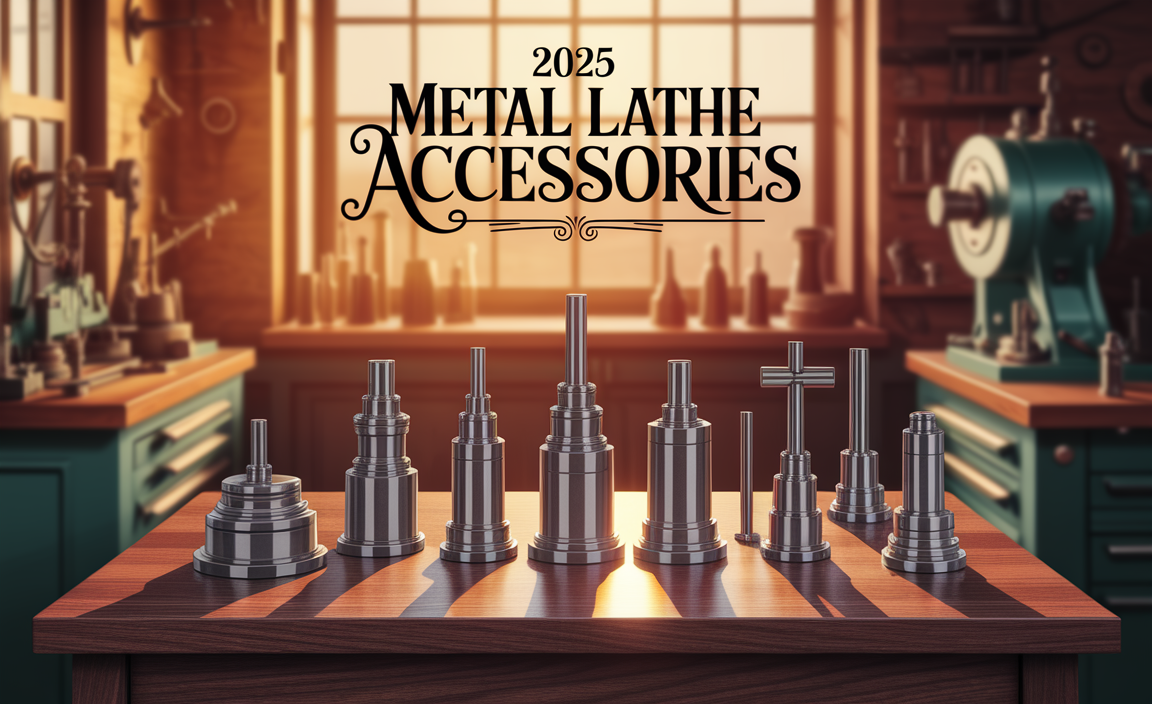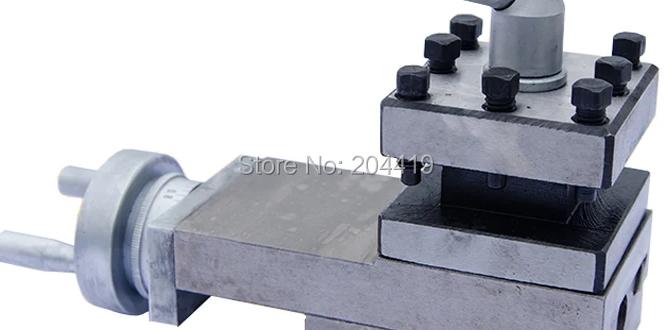For cutting 1/8 inch hardened steel (HRC60) with excellent chip evacuation, a high-quality carbide end mill with a specific geometry designed for tough materials is your best bet. Look for features like a short flute length for rigidity and a specialized coating.
Cutting hardened steel can feel like trying to carve rock with a butter knife. It’s a common frustration for machinists, especially when you’re working with smaller parts or need precise cuts. The wrong tool can lead to dull edges, broken bits, and hours of wasted effort. But don’t worry, achieving clean cuts in tough materials is absolutely possible! With the right knowledge and the correct 1/8 inch carbide end mill, you can conquer hardened steel. This guide will walk you through everything you need to know, ensuring you choose the right tool and use it effectively. Let’s get your milling projects back on track!
Choosing Your 1/8 Inch Carbide End Mill for Hardened Steel
When you hear “hardened steel,” especially at a high hardness like HRC60, you know you need something special. A standard end mill just won’t cut it. For this challenge, the 1/8 inch carbide end mill is often the go-to, but not all are created equal. We need to focus on specific features that make them excel in these demanding applications. Think of it like picking the right race car for a tough track – you need speed, durability, and precision handling.
Why Carbide?
Carbide, specifically tungsten carbide, is incredibly hard and maintains its hardness even at high temperatures. This is crucial because milling hardened steel generates a lot of heat. While it’s brittle and can chip, its superior hardness and heat resistance make it the undisputed champion for cutting difficult materials like hardened steel. High-speed steel (HSS) tools would simply wear out too quickly and lose their cutting edge.
Key Features for HRC60 Steel
For a 1/8 inch carbide end mill tackling HRC60, several features are paramount:
- Material Hardness: The end mill itself should be made from a very high-quality carbide grade.
- Number of Flutes: For hardened steel, especially at high hardness levels, fewer flutes are often better. A 2-flute or 3-flute end mill is typically recommended. More flutes can lead to chip packing and reduced chip evacuation, which is detrimental when cutting tough, stringy materials.
- Coating: A specialized coating is vital. Coatings like Titanium Nitride (TiN), Titanium Aluminum Nitride (TiAlN), or Aluminum Titanium Nitride (AlTiN) increase surface hardness, reduce friction, improve heat resistance, and extend tool life. Darker coatings like TiAlN and AlTiN are generally better for dry machining of difficult materials.
- Helix Angle: A higher helix angle (often 30 degrees or more) can help with chip evacuation and reduce cutting forces.
- Core Strength: A robust core design is essential to prevent the end mill from breaking under stress. Some end mills for hardened steel have a thicker core.
- End Geometry: Centers cutting end mills have a cutting edge on the end face, important for plunging. For slotting and profiling, this is less critical than the side cutting edges.
- Length of Reach: For a 1/8 inch end mill, extended reach can be a problem for rigidity. Shorter flute lengths are generally preferred for hardened steel to maximize strength. However, if you need to reach deeper, you’ll need a specifically designed long-reach tool.
The “Long Reach” Consideration
When we talk about a “long reach” 1/8 inch end mill for hardened steel, it’s a bit of a balancing act. Generally, for HRC60, you want as much rigidity as possible, which means a shorter tool. However, if your part geometry demands it, you might need an end mill with an extended flute length. In such cases, you’ll need to compensate with significantly reduced cutting parameters (depth of cut, width of cut, and feed rate) and rely heavily on a good coolant/lubrication system. A long reach tool for hardened steel also implies a need for impeccable machine rigidity and tramming. For instance, tooling from companies like Widia or Sandvik often has specific product lines for high-temperature alloys and hardened steels that incorporate these features.
Chip Evacuation: The Silent Killer
For any milling operation, especially in tough materials, effective chip evacuation is critical. When chips can’t clear the cutting zone, they re-cut, leading to increased heat, tool breakage, and poor surface finish. For a 1/8 inch end mill in hardened steel, this is amplified. Look for end mills designed with optimized flute geometry and potentially internal chip breakers for better chip management. This is where end mills specifically marketed for “high-performance” or “difficult-to-machine materials” shine.
Recommended Tool Specifications for 1/8 Inch Carbide End Mill
Navigating the vast options can be overwhelming. Here’s a breakdown of what to look for in terms of specifications to ensure you’re selecting a tool that’s proven for hardened steel.
General Specifications to Seek
When searching for the right tool, keep these in mind. They are general guidelines, and specific tool manufacturers may have slightly different recommendations.
- Diameter: 1/8 inch
- Shank Diameter: Often 1/8 inch or 1/4 inch. A 1/4 inch shank provides more rigidity for a 1/8 inch cutting diameter, especially if the tool has a reduced shank (a common feature on smaller end mills to prevent toolholder interference).
- Material: Solid Carbide
- Hardness Rating: Capable of cutting materials up to 60-65 HRC.
- Number of Flutes: 2 or 3 flutes recommended.
- Coating: AlTiN, TiAlN, or a similar high-performance coating for heat and wear resistance.
- Helix Angle: 30° to 45° for improved chip evacuation and cutting action.
- Type: Square End (for general profiling and slotting), Ball End (for 3D contouring), or Corner Radius (for added strength at corners). For hardened steel on a small diameter, square ends are common.
Example Tool Profiles
While naming specific brands can be tricky without direct endorsement, looking for tools described with terms like “High-Performance Carbide End Mill,” “Hardened Steel End Mill,” or “High-Feed End Mill” often points you in the right direction. Manufacturers like Iscar, Sandvik Coromant, Walter, and Kennametal offer excellent options, often with specific designations for hardened steel machining.
For example, a typical tool might be described as:
- “1/8” Dia. 4 Flute ZrN Coated Carbide End Mill for Hardened Steel” (Note: For HRC60, 2 or 3 flutes are often preferred over 4, but some aggressive geometries with specialized coatings might work. Always check manufacturer specs.)
- 1/8″ Diameter, 1/4″ Shank, 2-Flute, AlTiN Coated Carbide Ball End Mill, Long Reach, for High Hardness Steels.
Always consult the manufacturer’s specifications. They often provide recommended parameters for specific material hardness and tool types. Resources like the Machining Doctor website can also offer valuable insights and starting points for cutting parameters.
Essential Setup and Safety Precautions
Milling hardened steel, even with the right tool, demands a meticulous setup and an unwavering commitment to safety. This isn’t the time to cut corners.
Workholding is King
Your workpiece must be held absolutely securely. Any movement or vibration can lead to tool breakage and dangerous situations. Use high-quality clamps, vises with hardened jaws, or custom fixtures. Ensure the workpiece is flush and stable against the machine table. For small parts, consider using a sturdy vise or even bolting directly to the machine table if possible. A good quality milling vise is an indispensable tool in any home workshop.
Rigidity, Rigidity, Rigidity!
This cannot be stressed enough.
- Machine Rigidity: Ensure your milling machine itself is robust and well-maintained. Loose gibs or a wobbly spindle will severely limit your cutting ability.
- Toolholder Rigidity: Use the best quality toolholder you have. A high-precision collet chuck or end mill holder is far superior to a standard Weldon shank holder, especially at smaller diameters and higher speeds.
- Tool Stick-Out: Minimize the amount the end mill extends from the toolholder. For a 1/8 inch end mill, keep the stick-out to an absolute minimum, ideally less than 1/2 inch (or 4 times the cutting diameter).
Coolant and Lubrication
Dry machining hardened steel with small carbide end mills is generally not recommended due to extreme heat generation.
- Flood Coolant: The best option for dissipating heat and flushing chips.
- Mist Coolant/Lubrication: A good alternative if flood coolant isn’t feasible. It provides cooling and lubricates the cutting edge.
- Cutting Paste/Oil: For very small operations or specific materials, a high-quality cutting paste or oil can be applied sparingly.
Choose a coolant suitable for the steel you are machining. A soluble oil or synthetic coolant is often effective.
Personal Protective Equipment (PPE)
Always:
- Wear ANSI Z87.1 rated safety glasses or a full face shield.
- Wear hearing protection.
- Wear protective clothing that won’t get caught in the machine.
- Avoid gloves when operating rotating machinery, as they can get caught and cause serious injury.
- Keep your work area clean and free of clutter.
Best Practices for Cutting Hardened Steel (HRC60) with a 1/8″ End Mill
Now that you have the right tool and a safe setup, let’s talk about the actual cutting process. This is where technique makes all the difference.
The key to machining hardened steel is to keep cutting forces low and manage heat effectively. This often means using higher spindle speeds and lower depth-of-cut and feed rates than you might initially expect. The goal is to shear the material cleanly, not to rub or gouge it.
Speeds and Feeds: A Starting Point
Finding the perfect speeds and feeds often requires experimentation, but here’s where you can start. These are general guidelines and may need adjustment based on your specific machine, coolant, tooling, and the exact alloy of hardened steel.
For a 1/8 inch (0.125″) 2-flute carbide end mill with AlTiN coating, machining hardened steel (HRC60):
| Parameter | Recommended Range (Starting Point) |
|---|---|
| Spindle Speed (RPM) | 7,000 – 15,000 RPM (or maximum your machine can achieve reliably) |
| Surface Speed (SFM) | 200 – 400 SFM (This translates to the RPMs above based on diameter) |
| Feed Rate (IPM) | 3 – 10 IPM (This is relatively slow and depends heavily on depth of cut) |
| Depth of Cut (Axial DOC) | 0.005″ – 0.010″ (Very shallow to minimize stress and heat) |
| Width of Cut (Radial WOC) | 0.010″ – 0.040″ (For slotting, keep this small. For profiling edges, a small stepover is fine, but avoid engaging too much of the tool at once.) |
Important Notes on Speeds and Feeds:
- Listen to your machine: Noisy or chattering cuts indicate problems. Reduce feed or depth of cut.
- Watch the chips: Chips should be small, discrete, and ideally a light golden or blue color. Dark chips or melting chips mean too much heat. Bird’s nest chips mean poor evacuation.
- Climb Milling vs. Conventional Milling: For hardened steel, climb milling is often preferred. It engages the cutter at the thinnest point of the chip and exits at the thickest, reducing cutting forces and improving surface finish. Ensure your machine has minimal backlash for climb milling.
- Stepover: When profiling, a smaller stepover (e.g., 10-20% of the tool diameter) is generally better than a large one when machining contours or pockets.
- Dry Runs: It’s often a good idea to do a “dry run” (without the cut) at your programmed speeds and feeds to check for clearances and listen for any unusual sounds.
Using the End Mill Effectively
Here’s how to use your 1/8 inch carbide end mill for the best results:
- Plunging: If you need to plunge a hole, use a specialized center-cutting end mill. Plunge slowly (e.g., at a 45-degree angle or in a helical pattern) and use a very shallow plunge depth before transitioning to horizontal milling. Some end mills are designed for faster plunging.
- Slotting: When cutting a full slot, ensure your width of cut is appropriate. Too wide, and you’ll overload the tool. Use a tool with good chip evacuation features.
- Profiling: When milling around an external or internal profile, ensure your cutter compensation is set correctly in your CNC or that you are accounting for tool radius manually if using DROs.
- Peck Drilling: If machining deep holes with a solid end mill, implement a peck drilling cycle. This involves plunging a small amount, retracting fully to clear chips, and repeating.
Controlling Heat
Heat is your biggest enemy. Beyond coolant, consider:
- Tool Geometry: The end mill’s design, including its coatings and helix angle, plays a significant role.
- Cutting Parameters: Higher speeds, very shallow depth of cut, and appropriate feed rates are essential not just for chip load but also for managing heat.
- Chip Evacuation: Clean flutes mean less friction and heat. Ensure your coolant is flushing effectively.
It’s crucial to consult the specific manufacturer’s recommendations for the end mill you choose. Many manufacturers provide detailed cutting data tables for their tools. You can find excellent resources on tool manufacturer websites, such as those from Kennametal, which often include machining calculators and guides.
When to Consider Alternatives or Different Tools
While a 1/8 inch carbide end mill is excellent for many tasks on hardened steel, it’s not always the perfect solution for every situation. Understanding its limitations and when to look at alternatives can save you time and prevent frustration.
Limitations of Small Diameter End Mills
The primary limitation of any 1/8 inch tool is its rigidity and strength relative to its cutting diameter. When working with HRC60 material:
- Tool Breakage: Higher cutting forces and the brittle nature of hardened steel increase the risk of the small end mill breaking, especially if there are any sudden impacts or if parameters are too aggressive.
- Surface Finish: Achieving a mirror-like finish can be challenging due to the material’s hardness and the small cutting edges.
- Depth of Cut: You are severely limited in how deep you can cut in a single pass.
When a Different Tool Might Be Better
Consider these alternatives or complementary tools:
- Larger Diameter End Mills: If your part design allows, using a 1/4 inch or 3/8 inch end mill will provide significantly more rigidity and allow for higher depths of cut and feed rates, making the process faster and potentially more efficient.
- Ball Nose End Mills for Contouring: If you are doing complex 3D surfaces, a ball nose end mill of the appropriate diameter (again, larger is better for rigidity) is essential.
- Drill Mills / Combi Drills: For creating simple-shaped holes or pockets without needing extreme precision, a drill mill can combine drilling and milling actions effectively.
- EDM (Electrical Discharge Machining): For very intricate shapes, extremely hard materials, or when tool breakage is a high risk, EDM is a superior method. It cuts conductive materials using electrical sparks, without direct mechanical contact.
- Grinding: For achieving very high precision and surface finish on hardened steel, grinding is often the final step.
- Specialized Cutters:







